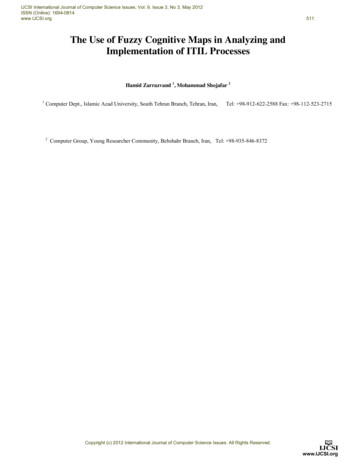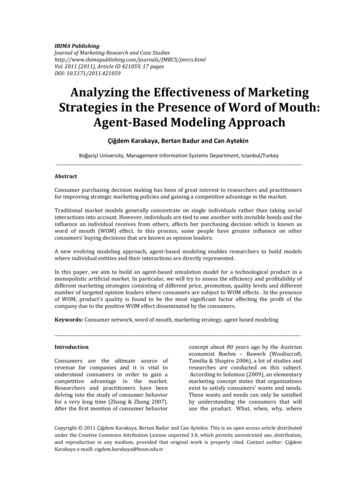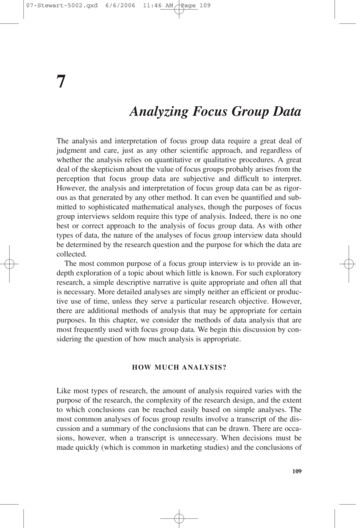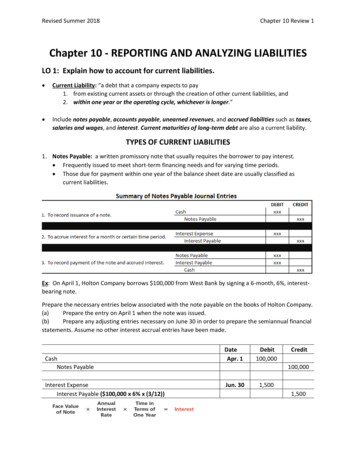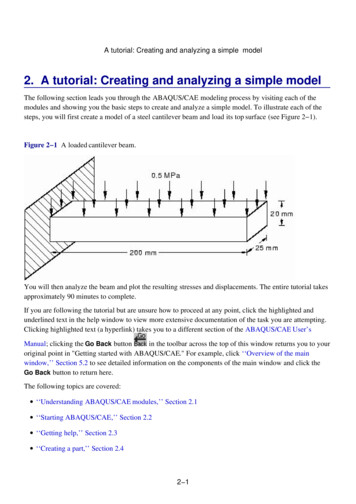
Transcription
Academy of Strategic Management JournalVolume 16, Number 1, 2017ANALYZING THE USE OF STRATEGICMANAGEMENT TOOLS AND TECHNIQUESBETWEEN IRANIAN FIRMSBagher Asgarnezhad Nouri , University of Mohaghegh ArdabiliMilad Soltani, European University of CyprusABSTRACTEnvironmental changes are among the most important concepts in recent years thathave trumpeted the need to adapt to the changes, just understood by the managers ofdifferent companies. Strategic management scholars, as one of the emerging areas ofexpertise in management science, have tried to provide managers with efficient tools to dealwith an increasingly complex environment. Range strategic management tools andtechniques are constantly being developed to suit the new environment. Accordingly, in thisarticle there has been tried to investigate the use of the tools and techniques of strategicmanagement in Iranian companies. The results show that the mission and vision statements,SWOT analysis, cost-benefit analysis, core competencies, financial analysis, critical successfactors, total quality management, price analysis, stakeholder analysis, and benchmarking,respectively as the ten tools of strategic management techniques, are widely known amongIranian managers. In addition, the use of these tools and techniques are not the same amongthe companies operating in various industries and having different size and ownership. Theyhave their own views on these techniques. The findings show that the use of strategicmanagement tools and techniques can play a positive role in improving corporateperformance.Keywords: Strategic Management, Strategic Management Tools and Techniques,Organizational PerformanceINTRODUCTIONIn recent years, the management world has been faced with many challenges.Changes in the business environment such as globalization (formation of trade unions andinternational economic treaties), changes in technology (production technology, informationtechnology, Internet and e-commerce), increased competition, focus on customers, andsocial, political, and cultural conditions have caused business environment to be dynamic.Therefore, the increased complexity of organizational activities has doubled the importanceof managers' decisions. Today, managers and decision-makers of the organizations more thanever need applicable mechanisms and procedures to make strategic decisions (RahnemayeRoudposhti, 2008). In such a condition, management scholars, using management tools andtechniques, have come to help the decision-makers of organizations. In the last two decades,managers have witnessed the emergence of several management tools. In fact, as managersneed to be active in markets, the introduction of management tools is highly competitive.Fortunately, nowadays, thanks to the advent of fast and relatively inexpensive systems ofinformation transition, a set of management tools is available to managers. Using these tools,managers can overcome the complex issues and, through making appropriate decisions, bringabout prosperity and progress for the organization and their employees (Rigby, 2015).Management tools and techniques can be used in different parts of managementincluding 1) general management, 2) marketing management, 3) operations management, 4)1
Academy of Strategic Management JournalVolume 16, Number 1, 2017financial management, 5) human resources management, 6) information technology, 7)management sciences, 8) planning and resource allocation, and 9) productivity and efficiency(Armstrong, 1993). Tools and techniques used in public management help managers andexecutives in decision-making processes. Other tools which are used in marketingmanagement process, are applied to identify and satisfy customers' needs and demands.Available tools and techniques of operations management are used to guarantee competitiveadvantages of production. Financial management includes tools which provide the basis fordecision-making in finances and prediction of the company's performance. Therefore,management tools and techniques are powerful leverages which help managers define andprovide solutions to the problems of the organization (Afonina, 2015).Now, the important question is that which management tool is better in overcomingthe issues and problems of the organization? The answer to this question depends to the kindof problem the organizations face with as well as internal and environmental conditionswhich govern them. Obviously, there is no tool as the master key of management locks.Managers and decision-makers must first identify and classify their issues and then, bystudying the functions and capabilities of management tools, select and use the appropriatetool or tools. In fact, managers should be more knowledge-based so that they can classifydifferent management tools and choose the right tool for their company. The selectionprocess of management tools is a complex issue like business issues. Thus, managers have tochoose those tools which can help them in decision-makings for the improvement ofprocesses, products, and services and provide them with better performance and greaterprofit. Hence, the proper use of these tools requires that managers be aware of the strengthsand weaknesses of each tool and be able to integrate and apply appropriate tools creatively,appropriately and at the right time. The mechanism of selecting and applying managementtools without having objective data is nothing but a random and dangerous play (Rigby,2015).The literature review shows that few studies have been hitherto conducted regardingthe recognition of the history of using and determining the importance of strategicmanagement tools and techniques and satisfaction of the managers with them. Among theseresearches mention may be made of Rigby (2015), Afonina (2015), Pasanen (2015), Kalkanand Bozkurt (2013), and Afonina and Chalupsky (2012). Such researches will lead to theidentification of benefits resulting from the application of these tools to help managers so thatthey can identify the right market conditions, make appropriate decisions in achievingpredetermined objectives, and have positive impact on the performance of differentcompanies; hence, the use of such tools will be expanded among managers. In fact, manywriters of strategic management have expressed that different kinds of these tools can beused according to the situation; however, as the nature of their function is not clear and thereis no guidance in this area, many organizations have faced with problems in using techniquesof strategic planning and suffered significant losses.Accordingly, the present study attempts to identify the most important strategic managementtools and techniques and, then, the use, importance, and satisfaction with these tools will beinvestigated from the viewpoint of the managers of some multinational and globalcompanies. To this end, theoretical basis of the research will be introduced in the secondsection; literature of the research is presented in the third section; the research method isdescribed in the fourth section; and the fifth part is dedicated to the data analysis. Finally,conclusion and recommendations of the research are provided in the last section of thearticle.2
Academy of Strategic Management JournalVolume 16, Number 1, 2017LITERATURE REVIEWDefinition of SMTTIn order to understand the essence of strategic management tools and techniques, aprecise definition of it should be presented. Despite the fact that researchers have paid muchattention to strategic management tools and techniques, there is no clear definition of thesetools and techniques. The researchers have provided some definitions in this area (Afoninaand Chalupsky, 2012). Thus trategic management tools and techniques are various tools thathelp managers in all areas of strategic management from strategic analysis to strategic choice(Afonina and Chalupsky, 2012).Importance of SMTTToday, the world economy is changing rapidly. Owing to the development ofcompetition, technological changes and globalization, organizations need to keep pace withchanging market conditions. Organizations should be more flexible so that they can findmore power to compete. Otherwise, they encounter problems and will disappear in longterm. In recent years, strategic management has gained importance within organizations. Thebasic model of strategic management includes a review of internal and external analysis,strategy formation, strategy implementation, evaluation and control. Strategic managementtools and techniques is an important element of strategic management. Information ondifferent strategic management tools and techniques is important not only for analyticalpurposes but also in providing business strategy and maintaining competitive advantage(Afonina and Chalupsky, 2012). Hence, the companies' managers and executives should seekappropriate tools and techniques so that they can assess the internal and external costs ofproduction or services, and have access to market information, product costs, customer needsanalysis, prediction and evaluation of organizational performance, and guarantee competitiveadvantages in their manufacturing activities (Afonina, 2015). Strategic management tools andtechniques provide the organizations with many advantages through which the managers canhave clear understanding of the available tools and techniques (Afonina and Chalupsky,2012). These techniques help the managers to change important information required forappropriate decisions and actions (Fleischer and Ben Soussane, 2003). The advantages ofthese tools include: increased awareness of the business environment, strategic issues,opportunities and threats which help to reduce the risks involved in making importantdecisions, prioritization of complex companies and providing a framework for assessing therelative importance of various business portfolios, and help the expression of complex issues(Frost, 2003).Insufficient Information about SMTTBased on what was said in the literature review section, it should be noted that thenumber of strategic management tools and techniques has been always increasing along withnew tools. Various tools and techniques have been provided to help managers identify thedecisions related to strategic planning (Ramanojam et al, 1986). Over the past few years, ithas been pointed out in scientific researches that strategic management tools and techniquesas well as the techniques existing in the literature should be understood. The researchers havepointed out the there is no conclusive report about strategic management tools and techniques(Clark 1997; Hughes 2007). However, a handful of researches have provided a useful list ofstrategic management tools and techniques (Afonina and Chalupsky, 2012). Therefore, in theenvironment turbulence conditions, market globalization managers have focused on the use3
Academy of Strategic Management JournalVolume 16, Number 1, 2017of different tools and techniques. Organizations' proper understanding of StrategicManagement Tools and Techniques is very important. As Hussey (1997) has pointed out,"techniques do not create strategy by themselves, but strategy formulation is theresponsibility of managers".RESEARCH BACKGROUNDRigby (2015), from 1993, through conducting some research on senior executivesaround the world, have ranked management tools and models. This ranking report for 2015,which has just been published on the website of this company, shows that customerrelationship management (CRM) is the most effective and widely used management tool.Ranking the use of assessed management tools and models is as follows: CRM,benchmarking, assessment of employee participation, strategic planning, Outsourcing,balanced scorecard, mission and vision statement, supply chain management, changemanagement programs, customer segmentation, analysis of metadata, core competency, totalquality management, mergers and acquisitions, business process reengineering, satisfactionand loyalty management, strategic alliances, time management in organizations, digitaltransformation, contingency planning and scenario, reduced complexity, price optimizationmodels, tools of decision-making right, zero-based budgeting and disruptive innovation. Atfirst glance, the most important change in ranking 2015 management tools is the change ofthe position of strategic planning tools from the most widely used management tool in 2012to the fourth-ranked tool in the current time. A detailed evaluation of the research resultsshow that this tool is still among the most popular and effective tools in North and SouthAmerica, but its application has reduced in Asia and Europe. The second important is thedeletion of key competencies from this list that in 2012 ranking was referred to as the sixthmost used management tools and model. In contrast, customer segmentation tool, which in2012 was removed from the list of top ten tools, has been again included among the mostwidely used management tools in the new report. Describing the emerged changes in theranking of 2015, Rigby (2015) refers to four major trends: 1. Seeking growth andaccelerating innovation in the changing environment of business; 2. Concerns about thegrowing cost and complexity as obstacles to growth; 3. Investment in the development of thedigital world in order to accelerate growth and innovation, overcome the complexities andcounter the risks; and 4. Customer understanding. In general, these four trends have changedbusiness environment in such way that some traditional management tools have lost theirrelative importance compared with new tools and models such as big data analysis.According to Rigby (2015), the main reason of this is the focus of emerging economies onthe use of new tools in order to bridge the gap between themselves and the developedeconomies. Afonina (2015) has investigated the use of strategic management tools andtechniques and determined the impact these tools have on the perform
(Armstrong, 1993). Tools and techniques used in public management help managers and executives in decision-making processes. Other tools which are used in marketing management process, are applied to identify and satisfy customers' needs and demands. Available tools and techniques of operations management are used to guarantee competitive advantages of production. Financial
